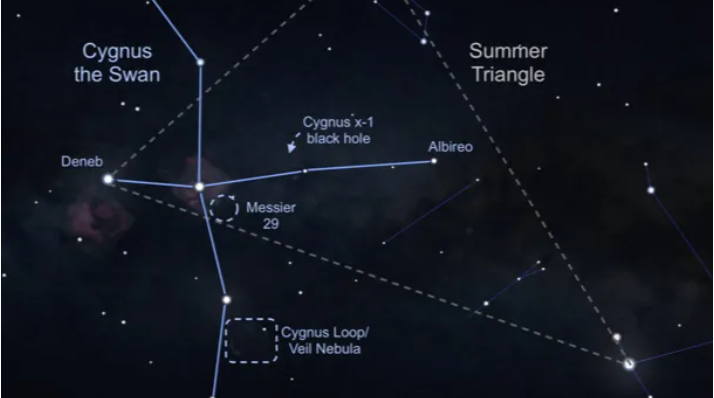A new mission involving a sounding rocket is on its way to space, aiming to unravel the mechanisms by which dramatic stellar explosions lay the foundation for the formation of nascent star systems.
 This image shows an illustration of the constellation Cygnus, Latin for “swan,” in the night sky. The Cygnus Loop supernova remnant, also known as the Veil Nebula, is located near one of the swan’s wings, outlined here in a rectangular box. Image Credit: NASA.
This image shows an illustration of the constellation Cygnus, Latin for “swan,” in the night sky. The Cygnus Loop supernova remnant, also known as the Veil Nebula, is located near one of the swan’s wings, outlined here in a rectangular box. Image Credit: NASA.
The INFUSE (Integral Field Ultraviolet Spectroscopic Experiment) sounding rocket mission was launched from the White Sands Missile Range in New Mexico at 9:35 p.m. MDT on October 29, 2023.
During a few months each year, the Cygnus constellation, Latin for "swan," gracefully traverses the night sky in the northern hemisphere. Just above its wing lies a popular target for backyard astronomers and professional scientists: the Cygnus Loop, also known as the Veil Nebula.
The Cygnus Loop represents the remnants of a star that once dwarfed the Sun in size, measuring roughly 20 times larger. Approximately 20,000 years ago, this massive star succumbed to its own gravitational forces and erupted in a spectacular supernova.
Even from a distance of 2,600 light-years, astronomers estimate that the resulting burst of light would have been so intense that it could have been visible from Earth even during daylight hours.
Supernovae play a vital role in the cosmic life cycle. These explosive events disperse heavy elements, produced in a star's core, into the surrounding clouds of dust and gas. They are responsible for seeding the universe with all elements heavier than iron, including those that compose their bodies.
Over time, the turbulent mix of gases and stardust left in the aftermath of supernovae gradually coalesces, giving rise to the formation of planets, stars, and entirely new star systems.
Supernovae like the one that created the Cygnus Loop have a huge impact on how galaxies form.
Brian Fleming, Research Professor, University of Colorado Boulder
Fleming serves as a lead investigator for the INFUSE mission.
The Cygnus Loop offers a unique opportunity to observe an ongoing supernova explosion. Currently spanning more than 120 light-years in diameter, this vast cloud is continuously expanding at a staggering pace of around 930,000 miles per hour (approximately 1.5 million km per hour).
What telescopes capture from the Cygnus Loop is not the direct explosion of the supernova. Instead, it observes the dust and gas that have been superheated by the shockwave, causing them to emit a luminous glow as they gradually cool down.
INFUSE will observe how the supernova dumps energy into the Milky Way by catching light given off just as the blast wave crashes into pockets of cold gas floating around the galaxy.
Brian Fleming, Research Professor, University of Colorado Boulder
To observe the searing edge of this shock front, Fleming and his team have engineered a telescope designed to detect far-ultraviolet light, a type of light that is too energetic for human vision.
This unique light source unveils gas temperatures ranging from 90,000 to 540,000 °F (about 50,000 to 300,000 °C), which continue to sizzle after the impact.
INFUSE functions as an integral field spectrograph, marking the first instrument of its kind to venture into space. This innovative device seamlessly merges the capabilities of two distinct light analysis methods: imaging and spectroscopy.
Conventional telescopes come equipped with cameras that excel at producing images, revealing the source of light and faithfully portraying its spatial arrangement. However, these telescopes do not disentangle light into different wavelengths or “colors;” instead, all the various wavelengths overlap in the resulting image.
On the contrary, spectroscopy takes a single beam of light and splits it into its constituent wavelengths or spectrum, akin to how a prism disperses light into a rainbow. This process unveils valuable information about the composition, temperature, and motion of the light source. Yet, spectroscopy can only examine one thin slice of light at a time, akin to peering at the night sky through a narrow keyhole.
The INFUSE instrument captures an image and subsequently dissects it into "slices," aligning these slices to form a single expansive “keyhole.” The spectrometer then fans out each of these slices into their respective spectra. This data can then be reassembled into a three-dimensional image, known as a “data cube,” resembling a stack of images where each layer reveals a specific wavelength of light.
Leveraging the data obtained from INFUSE, Fleming and his team will not only discern specific elements and their temperatures but also gain insights into the spatial distribution of these different elements along the shock front.
It’s a very exciting project to be a part of. With these first-of-their-kind measurements, we will better understand how these elements from the supernova mix with the environment around them. It’s a big step toward understanding how material from supernovas becomes part of planets like Earth and even people like us.
Emily Witt, Lead Graduate Student, University of Colorado Boulder
Witt took charge of the majority of the assembly and testing processes for INFUSE and will also lead the data analysis.
To reach space, the INFUSE payload will be transported via a sounding rocket. These agile, crewless rockets are launched into space for a brief period, typically a few minutes, to gather valuable data before descending back to Earth.
The INFUSE payload is set to embark on a two-stage Black Brant 9 sounding rocket, with a target peak altitude of approximately 150 miles (240 km). At this height, it will carry out its observations before returning to the ground via parachute for retrieval.
The team has aspirations to enhance the instrument and conduct future launches. Interestingly, components of the INFUSE rocket are repurposed from the DEUCE mission, which was previously launched from Australia in 2022.